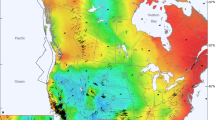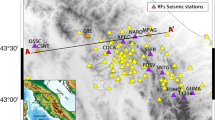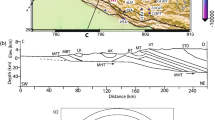Abstract
Shear-coupled teleseismic P waves sampling the interior of the Tibetan plateau provide evidence of systematic variations in crustal structure. The crust thins by up to 20 km from south to north with a concomitant increase in Poisson's ratio from normal values in the south to unusually high values in the north. This suggests that the crust of the northern plateau is partially melted due to high temperatures. These changes imply spatial and perhaps temporal variations in the way the elevation of the high plateau is created and maintained.
This is a preview of subscription content, access via your institution
Access options
Subscribe to this journal
Receive 51 print issues and online access
$199.00 per year
only $3.90 per issue
Buy this article
- Purchase on Springer Link
- Instant access to full article PDF
Prices may be subject to local taxes which are calculated during checkout
Similar content being viewed by others
References
Fielding E., Isacks, B., Barazangi, M. & Duncan, C. How flat is Tibet? Geology 22, 163–167 (1994).
Brandon, C. & Romanowicz, B. A "no-lid" zone in the central Chang-Thang Platform of Tibet: Evidence from pure path velocity measurements of long period Rayleigh waves. J. Geophys. Res. 91, 6547–6564 (1986).
Molnar, P. A review of geophysical constraints on the deep structure of the Tibetan Plateau, the Himalaya, and the Karakoram, and their tectonic implications. Phil. Trans. R. Soc. Lond. A 326, 33–88 (1988).
Owens, T. J., Randall, G. E., Wu, F. T. & Zeng, R. PASSCAL instrument performance during the Tibetan Plateau passive seismic experiment. Bull. Seismol. Soc. Am. 83, 1959–1970 (1993).
Zhao, W. et al. Deep seismic reflection evidence for continental underthrusting beneath southern Tibet. Nature 366, 557–559 (1993).
Nelson, D. et al. Partially molten middle crust beneath southern Tibet: Synthesis of Project INDEPTH results. Science 274, 1684–1687 (1996).
Hirn, A. et al. Seismic anisotropy as an indicator of mantle flow beneath the Himalayas and Tibet. Nature 375, 571–574 1995).
Wittlinger, G. et al. Seismic tomography of northern Tibet and Kunlun: Evidence for crustal blocks and mantle velocity contrasts. Earth Planet. Sci. Lett. 139, 263–279 (1996).
McNamara, D. E., Owens, T. J., Silver, P. G. & Wu, F. T. Shear wave anisotropy beneath the Tibetan Plateau. J. Geophys. Res. 99, 13655–13665 (1994).
McNamara, D. E., Owens, T. J. & Walter, W. R. Observations of regional phase propagation across the Tibetan Plateau. J. Geophys. Res. 100, 22215–22229 (1995).
Ni, J. & Barazangi, M. High-frequency seismic wave propagation beneath the Indian shield, Himalayan arc, Tibetan Plateau and surrounding regions: High uppermost velocities and efficient propagation beneath Tibet. Geophys. J. R. Astron. Soc. 72, 665–689 (1983).
Jordan, T. J. & Frazer, L. N. Crustal and upper mantle structure from Sp phases. J. Geophys. Res. 80, 1504–1518 (1975).
Zandt, G. & Randall, G. E. Observations of shear-coupled P-waves. Geophys. Res. Lett. 12, 565–568 (1985).
Baag, C. E. & Langston, C . A. Diffracted Sp generated under the Australian Shield. Geophys. J. R. Astron. Soc. 80, 363–386 (1985).
Langston, C. A. The SsPmp phase in regional wave propagation. Bull. Seismol. Soc. Am. 86, 133–143 (1996).
Bath, M. & Stefansson, R. S-P conversion at the base of the crust. Ann. Geofis. 19, 119–130 (1966).
Randall, G. E. Efficient calculation of complete differential seismograms for laterally homogeneous earth models. Geophys. J. Int. 118, 245–254 (1994).
Zandt, G. & Ammon, C. J. Continental crust composition constrained by measurements of crustal Poisson's ratio. Nature 374, 152–154 (1995).
Zhao, L.-S., Sen, M. K., Soffa, P. & Frohlich, C. Application of very fast simulated annealing ot the determination of the crustal structure beneath Tibet. Geophys. J. Int. 125, 355–370 (1996).
Zhu, L., Zeng, R., Wu, F., Owens, T. & Randall, G. Preliminary study of crust-upper mantle structure of the Tibetan Plateau by using broadband teleseismic body waveforms. Acta Seismol. Sinica 6, 305–316 (1993).
Zhu, L., Owens, T. J. & Randall, G. E. Lateral variation in crustal structure of the northern Tibetan Plateau inferred from teleseismic receiver functions. Bull. Seismol. Soc. Am. 85, 1531–1540 (1995).
Vandecar, J. & McNamara, D. E. 3-D upper-mantle velocity structure beneath the Tibetan Plateau (abstr.). Eos 77, F694 (1996).
Rodgers, A. J. & Schwartz, S. Y. Low crustal velocities and mantle lithospheric variations in southern Tibet from regional Pnl waveforms. Geophys. Res. Lett. 24, 9–12(1997).
Christiansen, N. Poisson's ratio and crustal seismology. J. Geophys. Res. 102, 3139–3156 (1996).
Beghoul, N., Barazangi, M. & Isacks, B. Lithospheric structure of Tibet and western North America: Mechanisms of uplift and a comparative study. J. Geophys. Res. 98, 1997–2016 (1993).
Holt, W. E. & Wallace, T. C. Crustal thickness and upper mantle velocities in the Tibetan Plateau region from the inversion of regional Pnl waveforms: Evidence for a thick upper mantle lid beneath southern Tibet. J. Geophys. Res. 95, 12499–12525 (1990).
Jin, Y., McNutt, M. K. & Zhu, Y. Mapping the descent of Indian and Eurasian plates beneath the Tibetan Plateau from gravity anomalies. J. Geophys. Res. 101, 11275–11290 (1996).
Butler, R. W. H. Thrust tectonics, deep structure, and crustal subduction in the Alps and Himalayas. J. Geol. Soc. Lond. 143, 857–873 (1986).
Makovsley, Y. et al. Structural elements of the southern Tethyan Himalaya crust from wide-angle seismic data. Tectonics 15, 997–1005(1996).
Yin, A., Murphy, M. A. & Harrison, T. M. Significant crustal shortening in the Lhasa block (southern Tibet) predates Indo-Asian collision. Geol. Soc. Am. Abstr Progm. 27, A-335 (1995).
Zhao, W.-L. & Morgan, W. J. Injection of Indian crust into Tibetan lower crust: A two-dimensional finite element model study. Tectonics 6, 489–504 (1987).
Herquel, G., Wittlinger, G. & Guilbert, J. Anisotropy and crustal thickness of Northern-Tibet. New constraints for tectonic modeling. Geophys. Res. Lett. 22, 1925–1928(1995).
Brown, L. D. et al. Bright spots, structure and magmatism in southern Tibet from INDEPTH seismic reflection profiling. Science 274, 1688–1690 (1996).
Makovsky, Y. et al. INDEPTH Wide-angle reflection observation of P-wave to S-wave conversion from crustal bright spots in Tibet. Science 274, 1690–1691 (1996).
Kind, R. et al. Evidence from earthquake data for a partially molten crustal layer in southern Tibet. Science 274, 1692–1694(1996).
Chen, L. et al. Electrically conductive crust in southern Tibet from INDEPTH magnetotelluric surveying. Science 274, 1694–1696 (1996).
Francheteau, J. et al. High heat flow in southern Tibet. Nature 307, 32–36 (1984).
Jin, Y., McNutt, M. K. & Zhu, Y. Evidence from gravity and topography for folding of Tibet. Nature 371, 669–674(1994).
England, P. C. Thompson, A. in Collision Tectonics (eds Coward, M. P. & Ries, A.C.) 83–94(Spec. Publ. 19, Geol. Soc. Lond., 1986).
McNamara, D. E., Walter, W. R., Owens, T. J. & Ammon, C. J. Upper mantle velocity structure beneath the Tibetan Plateau from Pn travel time tomography. J. Geophys. Res. 102, 493–505 (1997).
Turner, S. et al. Timing of the Tibetan uplift constrained by analysis of volcanic rocks. Nature 364, 50–54 (1993).
Zhang, S. & Karato, S. Lattice preferred orientation of olivene aggregates deformed in simple shear. Nature 375, 774–777 (1995).
Bird, P. Lateral extrusion of lower crust from under high topography, in the isostatic limit. J. Geophys. Res. 96, 10275–10286 (1991).
Tapponier, P., Peltzer, G. & Armjo, R. in Collision Tectonics (eds Coward, M. P. & Ries, A.C.) 115–157 (Spec. Publ. 19, Geol. Soc. Lond., 1986).
Leeder, M. R., Smith, A. B. & Yin,J. Sedimentology, paleoecology and paleoenvironmental evolution fo the 1985 Lhasa to Golmud Geotraverse. Phil. Trans. R. Soc. Lond. A 327, 107–143 (1988).
Harrison, T. M., Copeland, P., Kidd, W. S. F. & Yin, A. Raising Tibet. Science 255, 1663–1670 1992).
Molnar, P. & Lyon-Caen, H. Some Simple Physical Aspects of Mountain Building 179–207 (Spec. Pap. 218, Geol. Soc. Am., Boulder, CO, 1988).
Yin, A. et al. Tertiary structural evolution of the Gangdese thrust system in southeastern Tibet. J. Geophys. Res. 99, 18175–18201 (1994).
Author information
Authors and Affiliations
Rights and permissions
About this article
Cite this article
Owens, T., Zandt, G. Implications of crustal property variations for models of Tibetan plateau evolution. Nature 387, 37–43 (1997). https://doi.org/10.1038/387037a0
Received:
Accepted:
Issue Date:
DOI: https://doi.org/10.1038/387037a0
This article is cited by
-
Three-dimensional kinematics of the India–Eurasia collision
Communications Earth & Environment (2023)
-
Three-dimensional body wave crustal velocity structure and relocation of earthquakes in the Maduo area
Acta Geophysica (2023)
-
High-resolution Moho depth and Vp/Vs ratio distributions in northeast China from joint inversion of receiver functions and gravity data and their geological implications
Science China Earth Sciences (2023)
-
Different gravity anomaly, crustal structure, and uplift mechanism of the eastern and western Qinling Orogen revealed by full coverage gravimetry
Journal of Geodesy (2023)
-
Modeling the Crust and Upper Mantle Applying an Optimization Method to Multiple Datasets: Surface Wave Dispersion, P-Receiver Function, and S-Waveform
Pure and Applied Geophysics (2023)
Comments
By submitting a comment you agree to abide by our Terms and Community Guidelines. If you find something abusive or that does not comply with our terms or guidelines please flag it as inappropriate.



